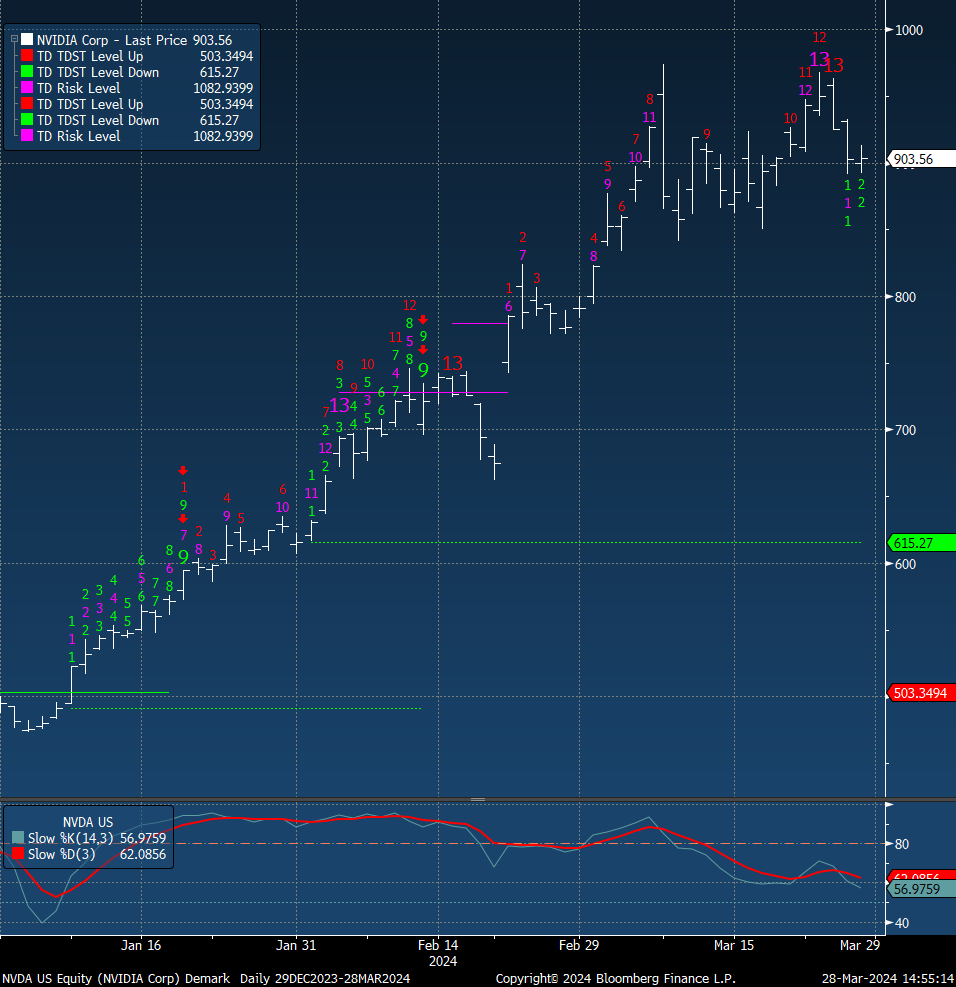No Stock Goes Up To Infinity, And Neither Will Nvidia
Submitted by Silverlight Asset Management, LLC on March 29th, 2024
Nvidia Corp. (NVDA) has experienced a remarkable run-up in its stock price.
To say the stock has been on a roll would be an understatement. Nvidia has gained 550% since the start of last year, added $2 trillion in market value over the past 15 months, and is responsible for about 29% of the S&P 500’s year-to-date gains.
After such a historic run, it’s natural to wonder if the stock is ahead of itself. The bear case is tough to make, though, because Nvidia isn’t just another meme stock run wild. It’s a real company with powerful fundamental tailwinds. Revenue doubled in the last fiscal year and is projected to rise another 81% this year. Revenue growth like that for such a large company is extremely rare.
Nvidia also has an exciting story that easily captures the imagination of investors. The world’s most valuable semiconductor company is at the center of a corporate arms race to boost computing power for AI workloads. The biggest companies in Silicon Valley are virtually tripping over each other to buy Nvidia’s most coveted chips.
Ever since ChatGPT debuted to the broad public, it’s been widely assumed that AI will be a very big market. But nobody knows precisely how big the market will become, or what Nvidia’s long-term market share will be. This allows investors to project whatever stratospheric growth rate assumptions they wish, and explains why the shares trade at a nosebleed valuation multiple of 37 times sales.
If you’re a long-term shareholder of Nvidia, congratulations—it’s been a wonderful ride. But how long can the vertical ascent continue?
In the Pixar movie Toy Story, there’s a quirky character named Buzz Lightyear. He exudes boundless enthusiasm for space exploration, frequently boasting that he can travel “to infinity and beyond.”
Yet, Buzz never really goes to infinity and beyond. That’s just a story in his head. A figment of his imagination. In reality, he was a toy stricken with a case of ebullient delusion.
Nvidia bulls aren’t as delusional as Buzz. But they may be too giddy for their own good. No stock goes up to infinity, and neither will Nvidia.
The semiconductor industry is notoriously volatile and prone to boom and bust cycles. Chipmakers have struggled at times to meet short-term swings in demand with long-term levels of production capacity, which can cause periods of oversupply and shortages.
Currently, the industry is in a boom period. But it’s unclear how long the current demand wave will last. Any slowdown in buying by major data center owners such as Microsoft, Amazon and Alphabet could dent Nvidia's revenue and growth estimates.
Nvidia, whose name is partly inspired by the Latin word for envy, is currently the most envied company on the planet. Success breeds competition. Numerous companies are now rushing to get a bigger piece of the AI chip market. For instance, Advanced Micro Devices launched its AI-accelerator last year and is forecasting significant revenue growth. Intel Corp. also has its own AI chips it will attempt to push into the marketplace.
According to Reuters, tech giants including Intel, Qualcomm and Google have formed a consortium named the UXL Foundation to "build a suite of software and tools that will be able to power multiple types of AI accelerator chips."
Nvidia may also face competition from companies that don’t even exist yet. Earlier this year, the Wall Street Journal reported that OpenAI’s CEO, Sam Altman, was seeking to raise trillions of dollars to significantly expand the world’s supply of semiconductor chips.
Another risk is that macro market conditions change. That’s because the factors that have been driving Nvidia’s manic price action stretch beyond just the company itself.
We have been in an era of excess liquidity ever since the Federal Reserve decided to massively expand its balance sheet in 2020 during the Covid-19 pandemic. And we also live in an era where passive investing has become a lot more popular, which favors stocks with the strongest momentum. When abundant liquidity mixes with the valuation agnostic investing approach used to construct passive portfolios, it’s an easy environment to see dramatic valuation overshoots.
A lesson from the Tech Bubble that burst in 2000 was that it usually doesn’t pay to buy stocks that trade over 10 times sales. At 37 times sales, Nvidia is well beyond that valuation. For me at least, that statistic alone says buyer beware. I don’t care how great Nvidia’s chips are, or how revolutionary the AI theme may be. I just don’t invest in stocks at that high of a valuation, because history shows it usually doesn’t work out well. If anyone has a backtest that disproves that notion, I’d love to see it.
Valuation matters a lot over the long run, but it has almost no signaling power in the short run. If Nvidia can trade at 37 times sales, it can just as easily trade at 107 times sales.
However, even from a trading perspective there are some yellow lights beginning to flash.
Year-to-date, the momentum factor has dramatically outperformed, which may leave it ripe for a correction. Global PMI surveys appear to be bottoming and commodities are breaking out to the upside. If inflation heats up again, it could easily cause a rotation out of high flying tech stocks into other areas of the market. Since Nvidia is the posterchild for momentum in this market, that could lead to an uncomfortable correction.
A trend is only your friend until it ends. One toolkit that helps diagnose when trend reversals are more likely to occur is the DeMark Indicators. I’ve written about these indicators before when I was attempting to sniff out a potential market bottom.
This week, Nvidia printed 13 exhaustion signals using DeMark’s TD Sequential and TD Combo indicators. If I were long Nvidia, this would concern me, because the stock flipped to bearish trend right after the 13s, and the next clear line of support is way down at $615. Another bearish trading signal is that momentum waned over the last month as the stock was making new highs (see bottom panel below). Wall Street traders call this a negative divergence.
Nvidia is a great company, but that doesn’t make it a great investment at any price. If you’re long, this may be a good time to consider taking profits. And if you’re considering buying shares for the first time, you may want to patiently wait for a better entry point.

Source: Bloomberg, DeMark Analytics
* Originally published by Forbes. Reprinted with permission.
Disclosure: This material is not intended to be relied upon as a forecast, research or investment advice. The opinions expressed are as of the date indicated and may change as subsequent conditions vary. The information and opinions contained in this post are derived from proprietary and non-proprietary sources deemed by Silverlight Asset Management LLC to be reliable, are not necessarily all-inclusive and are not guaranteed as to accuracy. As such, no warranty of accuracy or reliability is given and no responsibility arising in any other way for errors and omissions (including responsibility to any person by reason of negligence) is accepted by Silverlight Asset Management LLC, its officers, employees or agents. This post may contain “forward-looking” information that is not purely historical in nature. Such information may include, among other things, projections and forecasts. There is no guarantee that any of these views will come to pass. Reliance upon information in this post is at the sole discretion of the reader.
Testimonials Content Block
More Than an Investment Manager—A Trusted Guide to Financial Growth
"I’ve had the great pleasure of having Michael as my investment manager for the past several years. In fact, he is way more than that. He is a trusted guide who coaches his clients to look first at life’s bigger picture and then align their financial decisions to support where they want to go. Michael and his firm take a unique and personal coaching approach that has really resonated for me and helped me to reflect upon my core values and aspirations throughout my investment journey.
Michael’s focus on guiding the "why" behind my financial decisions has been invaluable to me in helping to create a meaningful strategy that has supported both my short-term goals and my long-term dreams. He listens deeply, responds thoughtfully, and engages in a way that has made my investment decisions intentional and personally empowering. With Michael, it’s not just about numbers—it’s about crafting a story of financial growth that has truly supports the life I want to live."
-Karen W.
Beyond financial guidance!
"As a long-term client of Silverlight, I’ve experienced not only market-beating returns but also invaluable coaching and support. Their guidance goes beyond finances—helping me grow, make smarter decisions, and build a life I truly love. Silverlight isn’t just about wealth management; they’re invested in helping me secure my success & future legacy!"
-Chris B.
All You Need Know to Win
“You likely can’t run a four-minute mile but Michael’s new book parses all you need know to win the workaday retirement race. Readable, authoritative, and thorough, you’ll want to spend a lot more than four minutes with it.”
-Ken Fisher
Founder, Executive Chairman and Co-CIO, Fisher Investments
New York Times Bestselling Author and Global Columnist.
Packed with Investment Wisdom
“The sooner you embark on The Four-Minute Retirement Plan, the sooner you’ll start heading in the right direction. This fun, practical, and thoughtful book is packed with investment wisdom; investors of all ages should read it now.”
-Joel Greenblatt
Managing Principal, Gotham Asset Management;
New York Times bestselling author, The Little Book That Beats the Market
Great Full Cycle Investing
“In order to preserve and protect your pile of hard-earned capital, you need to be coached by pros like Michael. He has both the experience and performance in The Game to prove it. This is a great Full Cycle Investing #process book!”
-Keith McCullough
Chief Executive Officer, Hedgeye Risk Management
Author, Diary of a Hedge Fund Manager
Clear Guidance...Essential Reading
“The Four-Minute Retirement Plan masterfully distills the wisdom and experience Michael acquired through years of highly successful wealth management into a concise and actionable plan that can be implemented by everyone. With its clear guidance, hands-on approach, and empowering message, this book is essential reading for anyone who wants to take control of their finances and secure a prosperous future.”
-Vincent Deluard
Director of Global Macro Strategy, StoneX

